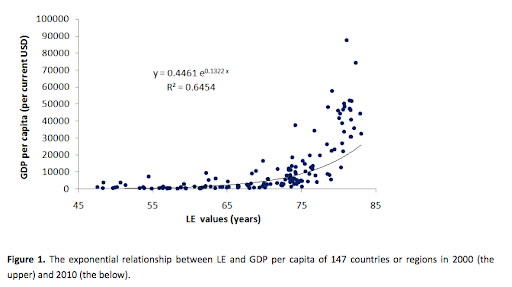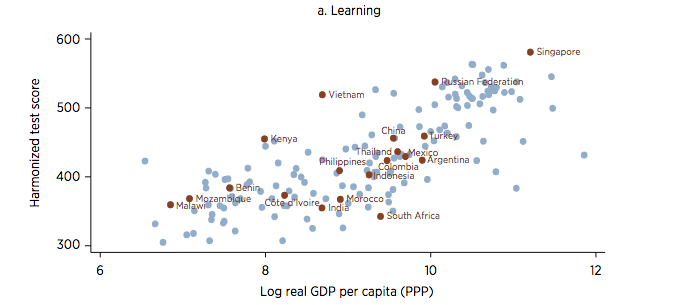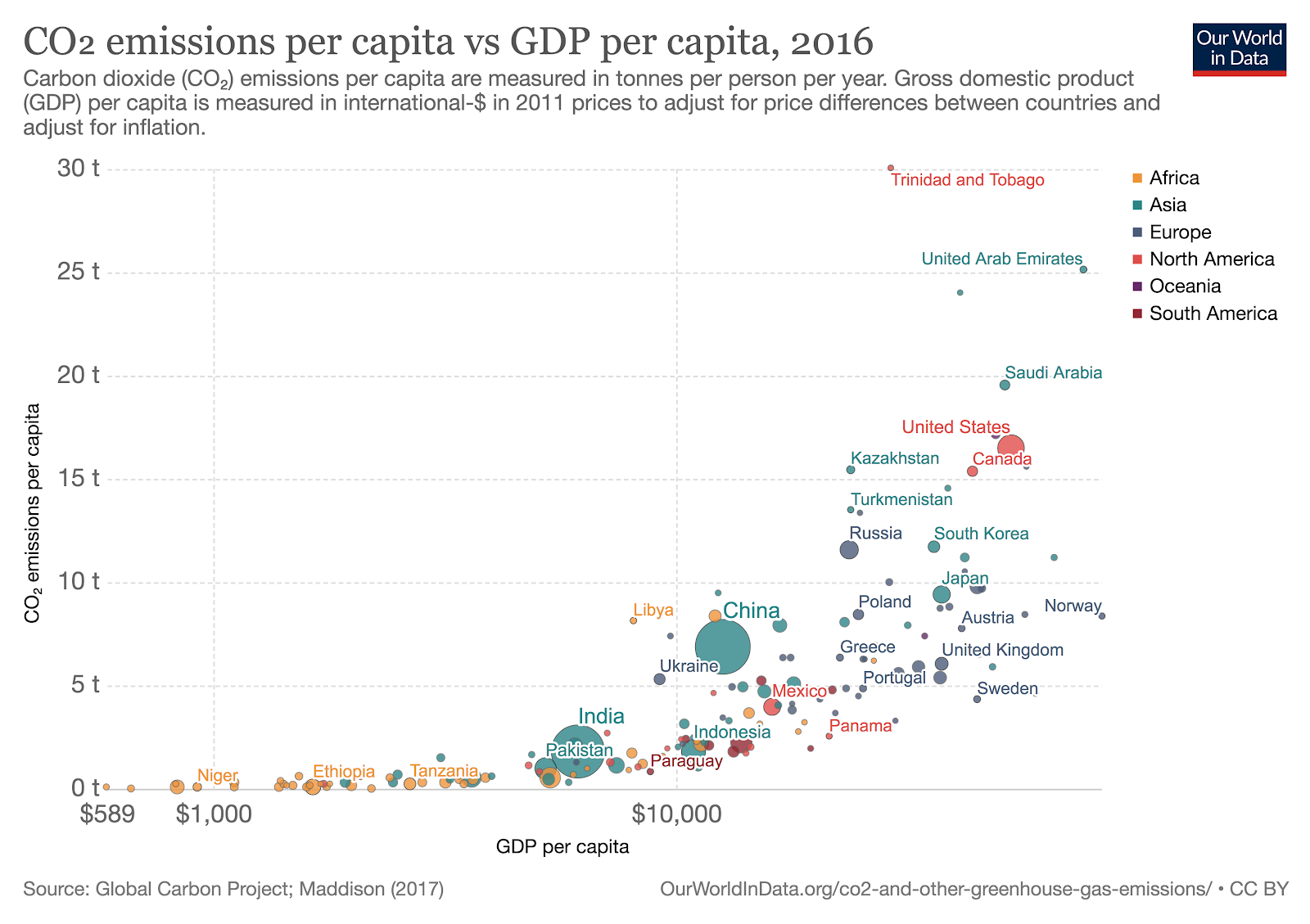
By Vanessa Thompson
Gross Domestic Product (GDP) has been a standard measure of economic growth and prosperity since the second world war. Its endurance for the last 70 years as a gold standard for economic health is remarkable, especially when it was only meant to measure production and jumpstart our economy for war. “Since its creation, economists who are familiar with GDP have emphasized that GDP is a measure of economic activity, not economic or social well-being.” However, GDP is often compared to life expectancy and overall welfare of a nation. As stated by the U.S. Federal Reserve, “Policymakers, government officials, businesses, economists and the public alike rely on GDP and related statistics to help assess the economy’s well-being and to make informed decisions.” Large policy and development organizations utilize GDP as a measure of economic “maturity.” Yet, if GDP only measures the monetary value of the production, how can it diagnose an entire economy and its prosperity? Not only is GDP an ill-equipped measure, but continuing to prioritize production is dangerous for the health of the planet and for the crises of the twenty-first century.
Background:
GDP was founded and presented by Simon Kuznets, who won the Nobel-Prize for his work, to the U.S. Congress in 1937. Congress needed to lift the American economy out of recession and put it on the path to be a global superpower. Global war was a threat and the U.S. needed a stronger military, a booming economy, and more weapons and overall production. “GDP estimates were used to show that the economy could provide sufficient supplies for fighting WWII while maintaining adequate production of consumer goods and services.” It became a global standard in the Bretton Woods Conference of 1944 when both the International Monetary Fund (IMF) and the World Bank were established. “Treasuries developing GDP methodologies for analyzing economic activity informed much of the discussion at the Bretton Woods meeting.”
The advantage of GDP is its correlation with positive metrics of human well-being. Factors like life expectancy (LE), childhood stunting from malnutrition, test scores in school, and a host of other factors can be correlated with GDP. Thus, organizations like the IMF and World Bank use it to determine economic development and the progress of a nation. As the IMF states, “GDP is important because it gives information about the size of the economy and how an economy is performing.”


Correlation vs. Causation:
You are probably familiar with the concept that, even if two variables are correlated, it does not mean one causes the other. For example, murders and the age of Miss America are correlated. Mozzarella consumption and number of engineering PhD graduates are also correlated. Thus, variables can be contextually unrelated but change in a similar numeric pattern.
It is especially easy to confuse correlation and causation in the case of GDP and economic well-being. To claim causality, we must be able to test a “treatment,” such as a medicine or policy, in a controlled experiment. This experiment must ensure that all other factors are held constant. Since this is impossible to do with an entire economy, researchers cannot conclusively claim that GDP causes any particular result.
Although GDP is correlated with positive factors of human well-being, there is no proof of causality. GDP can be confused as causing better living standards when it is only correlated with human well-being. GDP is a metric that only measures the monetary value of production. It does not consider education per capita, efficiency, innovation, or long-term factors like investment and savings. Thus, emphasizing GDP distracts from the main goal of tracking which countries have a healthy functioning economy.
Goals to improve GDP may lose sight of the more direct goal of improving human well-being. Even the founder of the GDP metric, Kuznets, did not support the use of GDP as an overall metric of national wellbeing. By his estimation, GDP failed to distinguish “between quantity and quality of growth, between costs and returns, and between the short and long run.” While GDP may be useful in some contexts, even its founder recognized that GDP is not a stand-alone statistic for evaluating an entire nation.
Further Issues with GDP:
GDP measures the monetary value of production but fails to recognize the quality of the goods or the value not associated with price. This measurement fails to value inventions that lower the costs of important items. In 2018, Mohamad Chisti, a doctor in Bangladesh, invented a way to build a ventilator for an infant that costs only $1.25. Most ventilators cost $6,000 to $15,000 to build and are a luxury of hospitals in wealthy nations. However, almost a million babies, most of them malnourished, die of pneumonia because they don’t have a ventilator to help them breathe. Chisti’s invention saves lives by reducing the price of ventilators from $15,000 to $1.25. However, a reduction in medical prices and costs would lower the GDP since the monetary value associated with those goods is lower. His invention is increasing the labor force and strengthening the economy, but these benefits are not reflected in the nation’s GDP metric. Focusing on GDP incentivizes high-priced overproduction of goods and services without consideration of the actual productivity, economic well being, or long-term effects of those products.
One of the greatest dangers of GDP is its correlation with carbon emissions. GDP does not consider short or long term externalities in the transaction cost. Its focus, instead, is on higher production. However, reducing our demand for goods and services lowers our carbon footprint since most companies produce emissions to transport and manufacture goods. To achieve this reduction, people can live a minimalist lifestyle, which also reduces consumer debt (through limiting unnecessary purchases) and raises overall happiness. Thus, the focus on production is one of the reasons GDP is a detrimental metric. According to the World Economic Forum, “GDP is a poor measure of progress—it increases as we destroy the natural capital of the planet.” Our World in Data published the image below, displaying the exponential regression correlation between national GDP per capita and carbon emissions per capita.
Furthermore, GDP does not consider the quality and social welfare of transactions. Dollars spent on fossil fuel electricity have the same weight as those spent on innovative renewable technologies that have long-term benefits. As published by the Institute of Environmental Science and Technology in Barcelona, “GDP is an estimate of the costs instead of the benefits of all market-related economic activities.” Although this form of measurement is important for the government to account for tax revenue, these monetary transactions and prices are not necessarily related to economic health. A movement towards an economic health emphasis and a quality-focused metric could only be catalyzed by a fundamental value shift in economics. “More broadly, there remains a reluctance to move away from viewing economics as a hard, mathematical science and accept the need to incorporate more of a social science mindset. In effect, we need another value shift in economics, comparable to those that shaped the last century—Keynesianism and neoliberalism.” However, as we have established, GDP is not a good metric even from a hard mathematical and economic standpoint. The metric fails in terms of both moral value and comprehensive economic measurement.
Alternatives to GDP:
The Index of Sustainable Economic Welfare (ISEW: Daly and Cobb, 1989) directly accounts for consumption related to well-being. The measurement is created by adding these social well-being services to GDP that would normally be omitted. For example, it includes housework, cost of traffic accidents, loss of natural areas, inequality among classes and genders, pollution, advertising, commuting, etc. “The ISEW can thus be considered as a measure of the benefits of economic activity.” It also corrects for inequality and environmental practices in production. Other alternatives similar to ISEW include ‘sustainable’ or ‘green(ed)’ GDP, which internalize environmental externalities in the metric and give rise to different pricing on goods based on these externalities. Some proposed metrics, like Rawlsian’s approach, also strive to distinguish “between measures of current well-being and measures of well-being over time.”
An approach that has gotten significant recognition is the World Happiness Index or Gross Domestic Happiness. This index measures the “subjective well-being and digs more deeply into how the social, urban and natural environments combine to affect our happiness.” The credibility of this type of indexes has grown in popularity. The issue with these alternatives to GDP is that they are not economic indicators. Depression, genetics, culture, background, diet, and many other non-economic factors can also dictate individual happiness levels and are, therefore, included in these alternative indexes.
Many of these indicators do not focus on growth unlike how GDP is normally interpreted. In fact, welfare tends to be quite stable in first-world, wealthy countries, so striving to increase it would be a futile objective. “But this line of thought [of not focusing on growth] is probably still one step too far for economists trained with the thought that progress is never-ending (and well approximated by GDP per capita).”
Conclusion:
GDP is an incredibly useful tool for measuring productivity, but it fails to address key economic facets of national economies, not only moral sociological ones. As stated by the World Economic Forum, “GDP is like a speedometer: it tells you whether your economy is going faster or slower. As in cars, a speedometer is useful but doesn’t tell you everything you want to know.” It does not describe whether an economy is running out of “fuel” or needs to call roadside assistance. It simply spotlights growth and speed. Bigger and more costly is better by GDP’s standpoint. If a speedometer is our main point of guidance, do we know where we are going?






